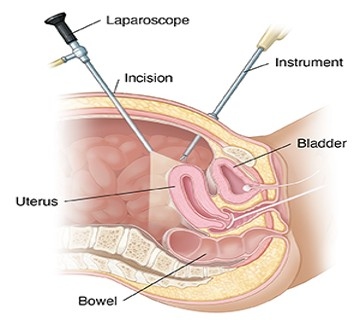
- Minimally Invasive: Small incisions are made to remove the uterus with a laparoscope, allowing faster recovery and smaller scars.
- Indications: Performed for conditions like fibroids, endometriosis, uterine cancer, and chronic pelvic pain.
- Procedure: Involves anesthesia, insertion of a laparoscope and instruments, removal of the uterus, and closure of incisions.
- Benefits: Faster recovery (2-4 weeks), less pain, fewer complications, and smaller scars compared to traditional open surgery.
Laparoscopic Hysterectomy: Detailed Overview
Laparoscopic hysterectomy is a minimally invasive surgical procedure to remove the uterus. It is performed using a laparoscope, a thin, flexible tube with a camera and light at the end, which allows the surgeon to view the inside of the abdomen and perform the surgery with small incisions. This procedure is often used for women with uterine conditions such as fibroids, endometriosis, uterine cancer, or chronic pain, who do not wish to retain their uterus.
🧬 What is Laparoscopic Hysterectomy?
A laparoscopic hysterectomy involves removing the uterus through several small incisions (typically 3-4), rather than one large incision. The surgeon uses specialized instruments and a camera (laparoscope) to guide the procedure. This method typically results in less pain, smaller scars, and faster recovery compared to traditional open surgery.
🏥 Indications for Laparoscopic Hysterectomy
Laparoscopic hysterectomy is recommended for various conditions, including:
- Uterine fibroids: Non-cancerous growths in the uterus causing pain or heavy bleeding.
- Endometriosis: Tissue similar to the uterine lining grows outside the uterus.
- Chronic pelvic pain: Unexplained pain in the pelvic region.
- Uterine cancer: Cancerous growths in the uterus.
- Abnormal bleeding: Severe bleeding that is not responding to other treatments.
- Prolapsed uterus: Uterus slips into the vaginal canal due to weakened pelvic muscles.
🛠️ Procedure Steps
- Anesthesia: General anesthesia is administered to ensure the patient is asleep and pain-free during the procedure.
- Incisions: Small incisions (0.5 to 1 cm) are made in the abdomen, typically near the belly button and below the pubic bone.
- Gas Insufflation: Carbon dioxide gas is used to inflate the abdomen, providing a clearer view of the pelvic organs.
- Laparoscope Insertion: A laparoscope is inserted through one incision to allow the surgeon to visualize the uterus and surrounding organs.
- Uterus Removal: The surgeon removes the uterus through one of the small incisions. In some cases, the cervix and ovaries may also be removed, depending on the patient’s condition.
- Closure: After the procedure, the incisions are closed using sutures or surgical glue.
🕒 Duration and Recovery
- Duration: The surgery typically takes 1-2 hours, depending on the complexity of the case and the patient’s anatomy.
- Hospital Stay: Most women can go home on the same day or after an overnight stay, though some may stay longer depending on their condition.
- Recovery Time: Recovery usually takes 2-4 weeks, which is significantly quicker than traditional open surgery. You may experience some pain, bloating, and fatigue, but these symptoms generally subside within a few days to weeks.
- Return to Normal Activity: Most women can return to light activities within 1-2 weeks and more strenuous activities in 4-6 weeks.
✅ Benefits of Laparoscopic Hysterectomy
- Minimally invasive with small incisions, leading to less scarring.
- Faster recovery and shorter hospital stay compared to abdominal hysterectomy.
- Less pain post-surgery, reducing the need for pain medication.
- Lower risk of infection and complications like blood loss.
- Preserves fertility (if ovaries are kept), or at least avoids major abdominal scars.
⚠️ Risks and Complications
Though laparoscopic hysterectomy is safer than traditional surgery, there are still risks involved, including:
- Injury to nearby organs: Rare, but the bladder, ureters, or bowel can be injured.
- Bleeding: Some bleeding is expected; excessive bleeding may require additional surgery.
- Infection: There’s a small risk of infection at the incision sites.
- Blood clots: Especially in the legs or lungs (deep vein thrombosis or pulmonary embolism).
- Anesthesia complications: As with any surgery involving anesthesia.
- Conversion to open surgery: In some cases, the laparoscopic procedure may need to be converted to an abdominal (open) surgery if complications arise.
🧪 Post-Operative Care
- Pain Management: Pain is usually mild to moderate and can be managed with over-the-counter pain relievers or prescribed medication.
- Diet: You may be advised to start with liquids and progress to solid foods after the surgery.
- Physical Activity: Avoid heavy lifting and vigorous exercise for 4-6 weeks to allow proper healing.
- Follow-up Appointments: Regular follow-up visits with the surgeon are necessary to ensure proper healing and address any concerns.
- Signs to Watch For: If you experience fever, excessive bleeding, or signs of infection at the incision sites, contact your healthcare provider immediately.
👶 Fertility Considerations
A laparoscopic hysterectomy results in the complete removal of the uterus, making pregnancy impossible after the surgery. If the ovaries are left intact, hormone production continues, so the woman will not enter menopause immediately (unless ovaries are also removed). Women who wish to preserve fertility should consider alternatives such as myomectomy or discuss fertility preservation options with their healthcare provider before undergoing the procedure.
🧾 Conclusion
Laparoscopic hysterectomy is an excellent treatment option for women with conditions affecting the uterus, offering a minimally invasive approach with faster recovery, less pain, and smaller scars compared to traditional open surgery. While it is generally safe, it is important to weigh the benefits and risks with your doctor, especially in terms of fertility considerations and the specific health condition.

